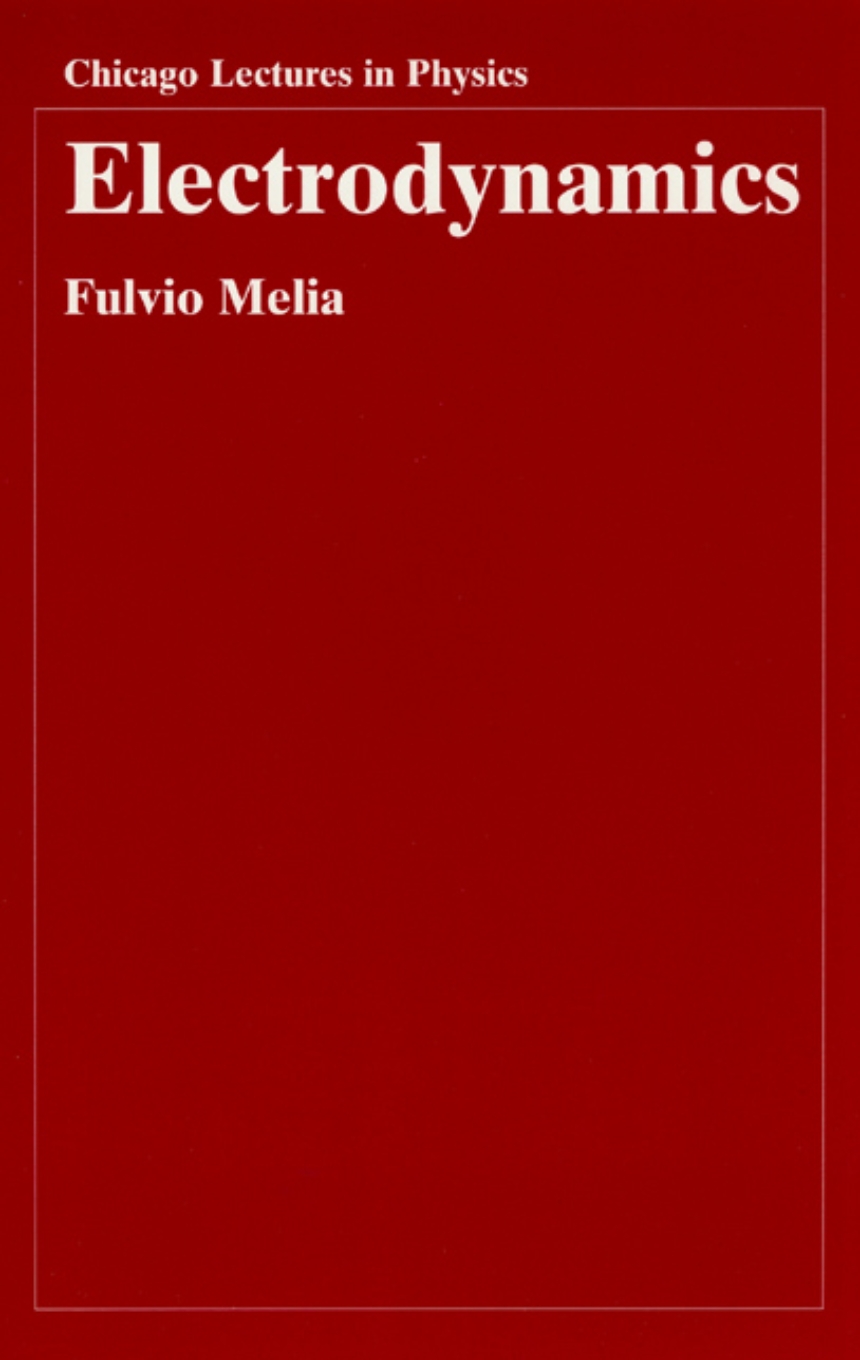Electrodynamics
Practically all of modern physics deals with fields—functions of space (or spacetime) that give the value of a certain quantity, such as the temperature, in terms of its location within a prescribed volume. Electrodynamics is a comprehensive study of the field produced by (and interacting with) charged particles, which in practice means almost all matter.
Fulvio Melia’s Electrodynamics offers a concise, compact, yet complete treatment of this important branch of physics. Unlike most of the standard texts, Electrodynamics neither assumes familiarity with basic concepts nor ends before reaching advanced theoretical principles. Instead this book takes a continuous approach, leading the reader from fundamental physical principles through to a relativistic Lagrangian formalism that overlaps with the field theoretic techniques used in other branches of advanced physics. Avoiding unnecessary technical details and calculations, Electrodynamics will serve both as a useful supplemental text for graduate and advanced undergraduate students and as a helpful overview for physicists who specialize in other fields.
Fulvio Melia’s Electrodynamics offers a concise, compact, yet complete treatment of this important branch of physics. Unlike most of the standard texts, Electrodynamics neither assumes familiarity with basic concepts nor ends before reaching advanced theoretical principles. Instead this book takes a continuous approach, leading the reader from fundamental physical principles through to a relativistic Lagrangian formalism that overlaps with the field theoretic techniques used in other branches of advanced physics. Avoiding unnecessary technical details and calculations, Electrodynamics will serve both as a useful supplemental text for graduate and advanced undergraduate students and as a helpful overview for physicists who specialize in other fields.
264 pages | 54 line drawings | 6 x 9 | © 2001
Physical Sciences: Experimental and Applied Physics, Theoretical Physics
Table of Contents
Preface
1. Introduction
1.1. The Physical Basis of Maxwell’s Equations
1.2. Maxwell’s Equations in Matter
1.3. The Mathematical Structure of Electrodynamics
1.3.1. Electrostatic Phenomena
1.3.2. Magnetostatic Phenomena
1.3.3. Wave Phenomena
1.3.4. The General Case
1.3.5. The Mathematical Apparatus
2. Time-Independent Fields
2.1. Electrostatics
2.1.1. Method 1: Guesses and Symmetries
2.1.2. Method 2: The Green Function
2.1.3. Expansions with Orthonormal Functions
2.2. Magnetostatics
2.2.1. Method 1: The Magnetic Scalar Potential
2.2.2. Method 2: The Magnetic Vector Potential
2.2.3. Method 3: Hard Ferromagnets
3. General Properties of Maxwell’s Equations
3.1. Time-Varying Fields
3.2. The Time-Dependent Green Function
3.3. Conservation Laws
3.3.1. Field Energy Density and Poynting’s Theorem
3.3.2. Conservation of Linear Momentum
3.3.3. The Maxwell Stress Tensor
3.3.4. Conservation of Angular Momentum
4. Electromagnetic Waves and Radiation
4.1. Electromagnetic Waves
4.2. Polarization and Stokes Parameters
4.3. Reflection and Refraction
4.4. Time Harmonic Fields in Matter
4.5. Wave Guides
4.6. Radiation
4.6.1. Point Currents and Liénard-Wiechert Potentials
4.6.2. The Radiation Fields
4.6.3. Simple Radiating Systems
5. The Need for the Special Theory of Relativity
5.1. Basic Principles and Transformations
5.2. Mathematical Structure of Four-Dimensional Spacetime
5.3. Lorentz Transformation Properties of Physical Quantities
5.4. Lorentz Transformation of Macroscopic Electrodynamics
5.5. Stress-Energy Momentum Tensor and Conservation Laws
6. The Lagrangian Formulation of Electrodynamics
6.1. Action Principles in Classical Field Theories
6.2. Relativistic Lagrangians of Point-Charge Motions
6.3. The Field Lagrangian
6.4. Invariances and Conservation Laws (Noether’s Theorem)
7. Relativistic Treatment of Radiation
7.1. The Green Function in Four-Dimensional Spacetime
7.2. Liénard-Wiechert Potentials and Fields for a Point Charge
7.3. Angular Distribution of the Emitted Radiation
7.4. Bremsstrahlung Radiation
7.5. Radiative Motions of a Point Charge
7.6. Radiation Damping and the Relativistic Lorentz-Dirac Equation
8. Special Topics
8.1. Time-Independent Multipole Fields
8.2. Multiple Expansion of Time-Dependent Fields
8.3. Collisions between Charged Particles
8.4. Magnetohydrodynamics
8.5. Alfvén Waves and Particle Acceleration
8.6. Synchrotron Emission
8.7. Echoes of the Big Bang
8.8. Cosmic Superluminal Sources
8.9. Polarized Radiation from the Black Hole at the Galactic Center
References
Index
1. Introduction
1.1. The Physical Basis of Maxwell’s Equations
1.2. Maxwell’s Equations in Matter
1.3. The Mathematical Structure of Electrodynamics
1.3.1. Electrostatic Phenomena
1.3.2. Magnetostatic Phenomena
1.3.3. Wave Phenomena
1.3.4. The General Case
1.3.5. The Mathematical Apparatus
2. Time-Independent Fields
2.1. Electrostatics
2.1.1. Method 1: Guesses and Symmetries
2.1.2. Method 2: The Green Function
2.1.3. Expansions with Orthonormal Functions
2.2. Magnetostatics
2.2.1. Method 1: The Magnetic Scalar Potential
2.2.2. Method 2: The Magnetic Vector Potential
2.2.3. Method 3: Hard Ferromagnets
3. General Properties of Maxwell’s Equations
3.1. Time-Varying Fields
3.2. The Time-Dependent Green Function
3.3. Conservation Laws
3.3.1. Field Energy Density and Poynting’s Theorem
3.3.2. Conservation of Linear Momentum
3.3.3. The Maxwell Stress Tensor
3.3.4. Conservation of Angular Momentum
4. Electromagnetic Waves and Radiation
4.1. Electromagnetic Waves
4.2. Polarization and Stokes Parameters
4.3. Reflection and Refraction
4.4. Time Harmonic Fields in Matter
4.5. Wave Guides
4.6. Radiation
4.6.1. Point Currents and Liénard-Wiechert Potentials
4.6.2. The Radiation Fields
4.6.3. Simple Radiating Systems
5. The Need for the Special Theory of Relativity
5.1. Basic Principles and Transformations
5.2. Mathematical Structure of Four-Dimensional Spacetime
5.3. Lorentz Transformation Properties of Physical Quantities
5.4. Lorentz Transformation of Macroscopic Electrodynamics
5.5. Stress-Energy Momentum Tensor and Conservation Laws
6. The Lagrangian Formulation of Electrodynamics
6.1. Action Principles in Classical Field Theories
6.2. Relativistic Lagrangians of Point-Charge Motions
6.3. The Field Lagrangian
6.4. Invariances and Conservation Laws (Noether’s Theorem)
7. Relativistic Treatment of Radiation
7.1. The Green Function in Four-Dimensional Spacetime
7.2. Liénard-Wiechert Potentials and Fields for a Point Charge
7.3. Angular Distribution of the Emitted Radiation
7.4. Bremsstrahlung Radiation
7.5. Radiative Motions of a Point Charge
7.6. Radiation Damping and the Relativistic Lorentz-Dirac Equation
8. Special Topics
8.1. Time-Independent Multipole Fields
8.2. Multiple Expansion of Time-Dependent Fields
8.3. Collisions between Charged Particles
8.4. Magnetohydrodynamics
8.5. Alfvén Waves and Particle Acceleration
8.6. Synchrotron Emission
8.7. Echoes of the Big Bang
8.8. Cosmic Superluminal Sources
8.9. Polarized Radiation from the Black Hole at the Galactic Center
References
Index
